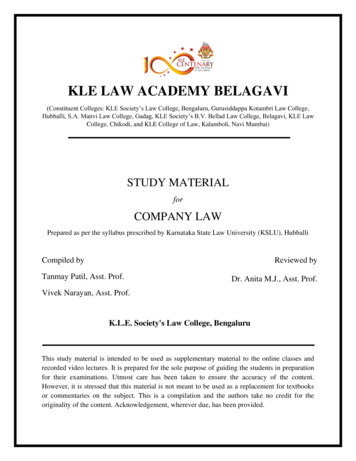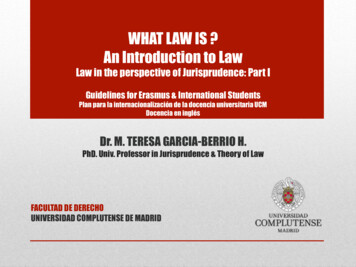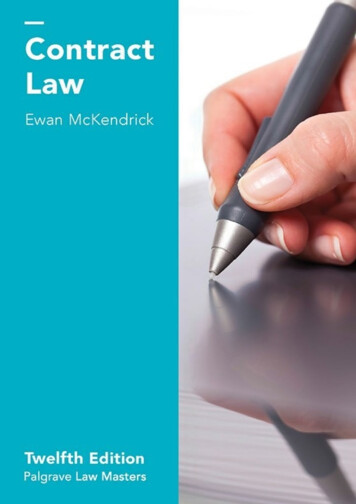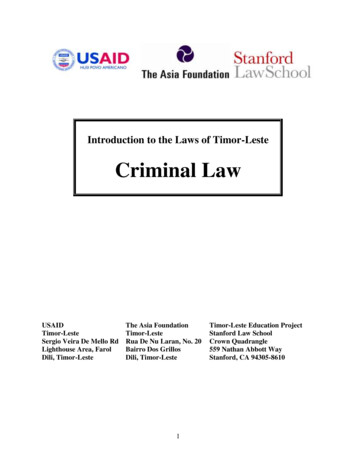
Transcription
KLE LAW ACADEMY BELAGAVI(Constituent Colleges: KLE Society’s Law College, Bengaluru, Gurusiddappa Kotambri Law College,Hubballi, S.A. Manvi Law College, Gadag, KLE Society’s B.V. Bellad Law College, Belagavi, KLE LawCollege, Chikodi, and KLE College of Law, Kalamboli, Navi Mumbai)STUDY MATERIALforCOMPANY LAWPrepared as per the syllabus prescribed by Karnataka State Law University (KSLU), HubballiCompiled byReviewed byTanmay Patil, Asst. Prof.Dr. Anita M.J., Asst. Prof.Vivek Narayan, Asst. Prof.K.L.E. Society's Law College, BengaluruThis study material is intended to be used as supplementary material to the online classes andrecorded video lectures. It is prepared for the sole purpose of guiding the students in preparationfor their examinations. Utmost care has been taken to ensure the accuracy of the content.However, it is stressed that this material is not meant to be used as a replacement for textbooksor commentaries on the subject. This is a compilation and the authors take no credit for theoriginality of the content. Acknowledgement, wherever due, has been provided.
CONTENTSl. No.ParticularsUnit - 11.2.3.4.5.6.7.8.Unit - 21.2.3.4.5.6.Unit - 31.2.3.4.5.6.7.Unit - 41.2.3.4.5.Unit - 51.2.3.4.5.SyllabusIntroduction and ConceptCompany - ConceptHistorical developmentNature and characteristics of companyKinds of companyCorporate personalityLimited liabilityLifting of corporate veilPromoters – duties and liability of promotersIncorporationProcedure of incorporationCertificate of incorporationMemorandum of Association (MOA)Articles of Association (AOA)Doctrine of indoor managementProspectusManagement and Control of CompaniesBoard of DirectorsMeetingsResolutionsDistribution of powers between Board of Directors and general meetingDirectorsCorporate social responsibilityPrevention of oppression and MismanagementFinancial structure of companySharesDividendsBuy backDebenturesAcceptance of Deposit by CompaniesReconstruction and amalgamation and winding upReconstruction, rehabilitation, and amalgamationWinding upModes of winding upWho can applyProcedure under different modesBibliographyPage 91251271341351461511611671761761802012022032052
SYLLABUSObjectives:In view of the important developments that have taken place in the corporate sector, thecourse is designed to understand the formation, management and other activities of the companies.Important regulations pertaining to the issue of shares and the capital raising have come into force.This course aims to impart the students, the corporate management, control, possible abuses, theremedies, and government regulation of corporate business and winding up of companies.Course contents:UNIT – IIntroduction and ConceptCompany – historical development – nature and characteristics of company – kinds of company –Corporate personality – limited liability – lifting of corporate veil – promoters – duties and liabilityof promotersUNIT – IIIncorporationProcedure of incorporation – certificate of incorporation – MOA – AOA – Doctrine of indoormanagement – prospectusUNIT – IIIManagement and Control of CompaniesBoard of Directors – powers and functions: Distribution of powers between Board of Directorsand general meetingDirectors: appointment – qualification – position of directors – types of directors – powers andduties of directors – remuneration – removalMeetings: Meetings of Board and Committees – kinds of meetings – procedure relating toconvening and proceedings at General and Other meetings – resolutions – Prevention of oppressionand MismanagementCorporate social responsibilityUNIT – IVFinancial structure of companySources of capital: Shares – types – allotment – transfer of shares – rights and privileges ofshareholders – dividends – declaration and payment of dividends, prohibition of buy back – privateplacement –3
Debentures – floating charge – appointment of debenture trustees and their duties – kinds –remedies of debenture holders – redemptionAcceptance of Deposit by Companies, charge on assetsUNIT – VReconstruction and amalgamation and winding upReconstruction, rehabilitation and amalgamation: concept – jurisdiction and powers of courts andNCLT – vesting of rights and transfer of obligations – takeover and acquisition of minority interestWinding up: concept – modes of winding up – who can apply – procedure under different modes.Prescribed Books:1. Taxman, Companies Act 2013.2. Singh, Avtar, Company Law, (Lucknow: Eastern Book Company,2007)Reference Books:1. Ramaiah,A, Guide to Companies Act, (Nagpur: Wadhwa, 1998)2. Shah, S.M., Lectures on Company Law, (Bombay: Tripathi, 1988)3. Kuchal, S.C, Corporation Finance: Principles and problems, 10th Edition, (ChaitanyaPublishing House, 1973)4. Y. D. Kulshreshta, Government regulation of financial management of private corporatesector in India, Indian Law Institute, (1986)5. S. K. Roy, Corporate Image in India A Study of Elite Attitudes towards Public and PrivateIndustry, (Shri Ram Centre for Industrial Relations and Human Resources ,1974)6. Gower, L.C.B, Principles of Modern Company Law, (London: Sweet & Maxwell, 1997)7. D. L. Majumdar, Towards a philosophy of Modern Corporation. (Asia Publishing House,1967)8. Pennington, Robert R., Pennington’s Company Law, (U.K: Oxford University Press, 2001)9. Rajiv Jain, Guide on foreign collaboration – Policies & Procedures (Vidhi Publication,2007).10. C. Singhania, Foreign collaborations and Investments in India – Law and procedures,(Fred B. Rothman & Co, 1999)11. Joyant M Thakur, Comparative Analysis of FEMA – FEMA Act, 1999 with FERA.12. Sanjiv Agarwal, Bharat’s guide to Indian capital, 2nd Edition, (New Delhi: Bharat LawHouse Pvt Ltd, 2001)Note: The course teachers have to keep track of the notification regarding enforcement of theCompanies Act, 2013 and teach the provisions enforced. For the provisions not enforced, theparallel provisions from the Act of 1956 are to be taught.4
UNIT – 1INTRODUCTION AND CONCEPTSynopsis Introduction Meaning of a Company Definition of Company Historical Development Nature and Characteristics of a Company Kinds of Company Corporate Personality Limited Liability Lifting of corporate veil Promoters Duties of Promoter Liabilities on PromoterIntroductionThe concept of ‘Company’ or ‘Corporation’ in business is not new but was dealt with, in 4thcentury BC itself during ‘Arthashastra’ days. Its’ shape got revamped over a period according tothe needs of business dynamics. Company form of business has certain distinct advantages overother forms of businesses like Sole Proprietorship/Partnership etc. It includes features such asLimited Liability, Perpetual Succession etc.After reading this lesson, you would be able to understand the historical development in theevolution of corporate law in India and England, emerging regulatory aspects including CompaniesAct, 2013, besides dealing with basic characteristics of the company and how it differs from otherforms of businesses.5
Meaning of a CompanyThe word ‘company’ is derived from the Latin word (Com with or together; panis bread), and itoriginally referred to an association of persons who took their meals together. In the leisurely past,merchants took advantage of festive gatherings, to discuss business matters.Nowadays, business matters have become more complicated and cannot be discussed at festivegatherings. Therefore, the company form of organization has assumed greater importance. Itdenotes a joint-stock enterprise in which the capital is contributed by several people. Thus, inpopular parlance, a company denotes an association of likeminded persons formed for the purposeof carrying on some business or undertaking.A company is a corporate body and a legal person having status and personality distinct andseparate from the members constituting it.It is called a body corporate because the persons composing it are made into one body byincorporating it according to the law and clothing it with legal personality. The word ‘corporation’is derived from the Latin term ‘corpus’ which means ‘body’. Accordingly, ‘corporation’ is a legalperson created by a process other than natural birth. It is, for this reason, sometimes called anartificial legal person. As a legal person, a corporation can enjoy many of the rights and incurringmany of the liabilities of a natural person.An incorporated company owes its existence either to a special Act of Parliament or to companylaw. Public corporations like Life Insurance Corporation of India, SBI etc., have been brought intoexistence by special Acts of Parliament, whereas companies like Tata Steel Ltd., RelianceIndustries Limited have been formed under the Company law i.e. Companies Act, 1956 which isbeing replaced by the Companies Act, 2013.Definition of CompanyIn the legal sense, a company is an association of both natural and artificial persons (and isincorporated under the existing law of a country). In terms of the Companies Act, 2013 (Act No.18 of 2013) a “company” means a company incorporated under this Act or under any previouscompany law [Section 2(20)].6
In common law, a company is a “legal person” or “legal entity” separate from, and capable ofsurviving beyond the lives of its members. However, an association formed not for profit alsoacquires a corporate character and falls within the meaning of a company by reason of a licenseissued under Section 8(1) of the Act.A company is not merely a legal institution. It is rather a legal device for the attainment of thesocial and economic end. It is, therefore, a combined political, social, economic and legalinstitution. Thus, the term company has been described in many ways. “It is a means of cooperationand organization in the conduct of an enterprise”.It is “an intricate, centralized, economic and administrative structure run by professional managerswho hire capital from the investor(s)”.Lord Justice Lindley has defined a company as “an association of many persons who contributemoney or money’s worth to common stock and employ it in some trade or business and who sharethe profit and loss arising therefrom. The common stock so contributed is denoted in money andis the capital of the company.The persons who contributed in it or form it, or to whom it belongs, are members. The proportionof capital to which each member is entitled is his “share”. The shares are always transferablealthough the right to transfer them may be restricted.”From the foregoing discussion, a company has its own corporate and legal personality distinctwhich is separate from its members. A brief description of the various attributes is given here toexplain the nature and characteristics of the company as a corporate body.Historical DevelopmentAs we all know that India has drawn a lot of legislation from England. Similarly, in the case ofCompanies law, India enacted company law based upon the company law enacted in England. Thethree phases which influenced the Company legislations may be divided as i) Colonization era; ii)Period after World War II & iii) the Opening up of Indian markets in the year 1990.7
Legislation EnactedIn the year 1850, the first Company enactment for the registration of the joint-stock company wasintroduced in India. This enactment as mentioned before was based upon the English CompaniesAct, 1844.Later in the year 1857, the concept of limited liability was recognized in the companies legislationbut the said limited liability was not extended to the banking company. The concept of limitedliability into the Companies Act was introduced earlier in the English Companies Act of 1856. Butby the year of 1858, the concept of limited liability was extended to banking company even inIndia.In the year 1866 Companies Act was yet again passed for consolidating and amending the lawsrelating to incorporation, regulation and winding up of trading companies and other associations.This Act was based upon the Companies Act 1862 of England. This Act was recast in the year1882 and was in use until 1913.In the year 1913 another Indian Companies Act was enacted based upon English CompaniesConsolidation Act, 1908. Companies Act of 1913 was amended in the year 1914, 1915, 1920,1926, 1930 and 1932. But the major amendment to the Companies Act of 1913 who was made inthe year 1936 this amendment was based upon the English Companies Act. 1929. The act of 1913regulated the Indian business company until 1956.By the end of 1950, Bhabha committee was set up under the chairmanship of H. C. Bhabha. Forthe difference of Indian Companies Act with reference to the development of Indian trade andindustry.The committee submitted its report on 1952, this report of Bhabha committee was acceptedCompanies (Amendment) Act, 1956. This legislation was made keeping in mind the Englishlegislation of Companies Act in 1948.Act of 1956The period of the Second World War and the post-war years witnessed an upsurge of Industrialand commercial activity on an unprecedented scale in India and large profits were made bybusinessmen through incorporated companies. The Government of India took up the revision of8
Company Law immediately after the termination of the last war. Two company lawyers— onefrom Bombay and the other from Madras— were successively appointed to advise Governmenton the broad lines on which, the Indian Companies Act, 1913, should be revised and recast in thelight of the experience gained during the war years. Their reports were considered by Governmentand a memorandum embodying its tentative views was circulated towards the end of 1949 foreliciting an opinion.On 28th October 1950, the Government of India appointed a Committee of twelve membersrepresenting various interests under the chairmanship of Shri H. C. Bhabha, to go into the entirequestion of the revision of the Companies Act, with particular significance to the development oftrade and industry of India. This Committee, popularly known as the Bhabha Committee,submitted its report in March, 1952, recommending comprehensive changes in the Companies Actof 1913. The report of the Bhabha Committee was again the subject of discussion and commentby Chambers of Commerce, Trade associations, professional bodies, leading industrialists,shareholders and representatives of labour. The Bill, which eventually emerged as the CompaniesAct, 1956, was introduced in Parliament on 2nd September 1953. IT was a comprehensive andconsolidating as well as amending piece of legislation. The Bill was referred to a Joint Committeeof both Houses of Parliament in May 1954. The Joint Committee submitted its report in May 1955,making some material amendments to the Bill. The Bill, as amended by the Joint Committee,underwent some further amendments In Parliament and was passed in November 1955. The newCompanies Act (I of 1956) came into force from 1st April 1956.Major Changes brought forth by the Companies Act 1956 Promotion and growth of Companies. Capital structure of the Companies. Company meetings and procedures. Company accounts and its presentation & powers and duties of the auditors of thecompany. Inspection and investigations of the affairs of the Company. The constitution of the Board of Directors, Powers and functions of directors, ManagingDirectors and Managers; and Administration of the Company Law.9
The Amendments in the Companies Act, 1956As any other legislation various amendments were made to the Companies Act 1956 as mentionedbelow:Timeline of 198519881991Opening of the market gates to the Globe-1990The Era of liberalisation, privatization and globalisation saw the anachronistic Companieslegislation made in time of closed market and hence inadequate to handle the global entry. Thisnon-conducive legislation would have obstructed the Indian Corporate Sector. In pursuance to thisnecessity the Companies Bill, 1993 was formed but was later withdrawn. The Depositories Act,1996 was introduced in India and later a working Group was constituted to rewrite the CompaniesAct, 1956. In pursuance to above made effort the Companies Bill, 1997 was introduced in RajyaSabha on August 14, 1997 in order to replace the prior legislation.The President of India promulgated the Companies (Amendment) Ordinance, 1998 on October 31,1998. But this promulgated the Companies (Amendment) Ordinance, 1998 was soon replaced bythe Companies (Amendment) Act, 1999.The objectives of the Companies (Amendment) Act, 1999: To surge the capital market by boosting the morale of the National business houses. Fostering the FITs and Foreign Direct Investments in the country.The changes brought by the Companies (Amendment) Act, 1999 are: A facility was introduced to allow the Corporate Sector to buy-back company’s own share. Provisions relating to investments and loans were liberalised and rationalised. Requirement of prior approval of the Central Government on investment decisions wasdone away with and companies were allowed to issue “sweat equity” in lieu of theintellectual property. The compliance of the Indian Accounting Standard was made mandatory and the NationalCommittee on Accounting Standard was also incorporated.10
The benefit of the investors was looked into by setting up “Investor Education andProtection Fund”. Introduction of the nomination to shareholders, debenture holders, etc.Later, the Companies (Amendment) Act, 2000 was enacted, which was followed by the Companies(Amendment) Act, 2001 wherein the Section 77A was introduced in relation to buy-back of theshares. This amendment allowed the Board of Directors to buy-back the shares upto 10% of thepaid-up capital and free reserves provided not more than one such buy-back is made during theperiod of 365 days. Then, the Companies (Amendment) Act, 2002 was enacted which wasfollowed by the Companies (Second Amendment) Act, 2002. The first amendment introduced thesetting-up and regulation of the Cooperatives as a body corporate under the Companies Act, 1956to be called ‘Producer companies. The Second Amendment was to expedite the winding-upprocess of the companies to facilitate rehabilitation of the sick companies and protection ofworkers interest.The Companies (Amendment) Act, 2006, was brought into force on 1.11.2006 wherein itintroduced the Director Identification Number (DIN) and also introduced electronic filing ofvarious returns and forms.The New Enactment of the New SocietyThe Companies Act, 2013 replaced the Companies Act, 1956. The legislators introduced ideas ofthe likes of: Corporate Social Responsibility (CSR) Class action suits Fixed term for the Independent Directors The provision of raising money from the public was made little stringent Prohibition on insider trading by company directors or key managerial personnel bydeclaring such activities as a criminal offence It permits shareholder agreements providing for the ‘Right of First Offer’ or ‘Right of firstRefusal’ even in the case of Public Companies11
The Companies (Amendment) Act, 2015: It received the presidential assent on May 2015 andbecame operate on 29th May 2015. It is designed to address the issues of the stakeholders such asChartered Accountants and other professionals.Key Amendments brought in by the Companies (Amendment) Act, 2015 may be explained asfollows:No minimum Paid-up share CapitalNo minimum paid-up share Capital requirements will now apply for incorporating private as wellas Public Companies in India.Relaxation in relation to related party transactionIn the case of related party transactions which requires stake-holders approval relaxation has beengiven wherein earlier required special resolution has been replaced by the ordinary resolution.Inspection of the resolution filed with the RegistrarThis Act has limited public access of such resolutions relating mainly to the strategic businessmatters. Such documents will no longer be available for the public to review or permitted to takecopy of.Common Seal OptionalUnder the Act of 2013 it was required to affix common seal on certain documents but, now afterthe Act of 2015, the use of the common Seal has been made optional although the common seal isone of the integral characteristics of a Company.Violations of Acceptance of DepositsCompanies Act of 2013 provisions in relation to the Acceptance/ renewal/ repayment of deposits.However no specific penalty prescribed for the new compliance with the relevant provisioni.e. Section 13 and Section 76.A new Section 76A has been introduced for these non-compliances. The defaulting company willbe liable for a minimum fine of INR 1 crore and maximum amount of INR 100 crore in additionto the amount of deposit or part thereof along with interest.12
DividendThe Companies Act, 2015 has introduced a proviso which states that a company must set-off thelosses and depreciation carried over from past years against the profits of the company beforedeclaring dividend for a financial year.The Companies (Amendment) Act, 2017The Companies (Amendment) Bill, 2016 was intended to be passed by the legislature, but afterreferring it to the Committee this Bill went through a lot of corrections and metamorphosed intoThe Companies (Amendment) Bill, 2017 which was then passed as the Companies (Amendment)Act, 2017. The salient features of the amendments brought by this Act are: Synergy with SEBI and RBI Rules: For the first time, several provisions have beenamended to align the Act with various rules and regulations of the SEBI (SecurityExchange Board of India) and the RBI (Reserve Bank of India). For example, Sections 194and 195 of the Act, which was dealing with the offence of insider trading and forwarddealing, have now been omitted since the SEBI regulations were succinct to cover all. The instances of such frauds. Further disclosures to be made in the prospectus have alsobeen aligned with the SEBI’s power to regulate IPOs (Initial Public Offering). Thedefinition of ‘debenture’ has been amended to permit RBI to disqualify certain instrumentsas debentures. Proportionality of penalties: The quantum of penalty will now be levied taking intoconsideration the size of the company, nature of business, injury to public interest, natureand gravity of default, repetition of default, etc. which is one of the most appreciatedamendments. Two new provisions regarding the determining of the level of punishmenthave been freshly introduced and lesser penalties for one person companies and smallcompanies were inserted. Provisions for small companies and penal vigour has beenreduced. Placement process made easier in Private Sector: The placement process is rationalised bydoing away separate offer letter details to be kept in the records of the Company and hencereducing the number of filings to Registrar. The company is not allowed to use money fromprivate placement unless allotment made and the return of the same filed with the13
registrar To make sure that an investors are informed, the disclosures are made underExplanatory Statement as provided in Rule 13(2)(d) of Companies (Share Capital andDebenture) Rules, 2014, embodied in the Private Placement Application Form. Change indefinition of private placement is proposed to umbrella all securities offers and invitationsother than rights. The Companies would be allowed to make an offer of multiple securityinstruments simultaneously. Standards for Independent Director : Section 149 of the Act deals with the qualificationsand disqualifications of independent directors. Sub-Section (6) provides for variousdisqualifications for becoming an independent director, one of which is, such a personhaving “pecuniary relationship” with “the company, its holding, subsidiary or associatecompany, or their promoters, or directors”. The amendment clarified that ‘pecuniaryrelationship’ excluded the remuneration of director having transaction not exceeding 10%of his total income or such amount as may be prescribed.The Companies (Amendment) Act, 2019The Companies (Amendment) Act, 2019 received the assent of the President on the 31st July 2019.While introducing the Bill in the Lok Sabha, the Hon’ble Finance and Corporate Affairs Minister,Nirmala Sitharaman said, “the Bill seeks to ensure more accountability and better enforcement tostrengthen the corporate governance norms and compliance management in corporate sector asenshrined in the Companies Act, 2013”.In order to review the Companies Act and to gain better compliance, the Government of Indiaconstituted a Committee in July 2018. The said Committee, after taking the opinions of severalstakeholders of the Company, submitted its Report in August, 2018. The Committeerecommended that serious offences must face rigour of law, but technical mistake be given inhouse adjudication for speedy redressal. Accordingly, proposal to amend certain provisions of theCompanies Act, 2013 was made, however, in view of the urgency, the Companies (Amendment)Ordinance, 2018 was promulgated on November 2018. To replace the aforesaid Ordinance, theAmendment Bill was introduced in Lok Sabha and passed, but Bill was not taken up in RajyaSabha. Therefore, to continue the effect of prior ordinance the President promulgated theCompanies (Amendment) Ordinance, 2019 on the 12th day of January 2019 and the Companies14
(Amendment) Second Ordinance, 2019 on the 21stday of February 2019. Then the Companies(Amendment) Bill, 2019 was passed by both the houses of parliament and became the law.The Major reforms undertaken by the Ordinance of 2018 and 2019 include the following:1. Re-categorisation of offences which are in the category of compoundable offences to anin-house adjudication framework. However, no change has been made for any of the noncompoundable offences.2. Ensuring compliance of the default made and prescribing deterrent penalties in case ofrepeated defaults.3. Delegation and De-clogging the NCLT by: Enlarging the jurisdiction of Regional Director (“RD”) by increasing the pecuniarylimits up to which compounding of offences under Section 441 of the Act can takeplace. Vesting in the Central Government the power to approve the alteration in the financialyear of a company under Section 2(41). Vesting the Central Government, the power to approve cases of conversion of publiccompanies into private companies so as to reduce the burden on the government anddeveloping the sector. Other reforms include re-introduction of declaration of commencement of businessprovision; greater accountability with respect to filing documents related to creation,modification and satisfaction of charges; non-maintenance of registered office totrigger de-registration process; holding of directorships beyond permissible limits totrigger disqualification of such directors.Nature and Characteristics of a CompanySince a corporate body (i.e. a company) is the creation of law, it is not a human being, it is anartificial juridical person (i.e. created by law); it is clothed with many rights, obligations, powers,and duties prescribed by law; it is called a ‘person’.Being the creation of law, it possesses only the powers conferred upon it by its Memorandum ofAssociation which is the charter of the company. Within the limits of powers conferred by thecharter, it can do all acts as a natural person may do.15
The most striking characteristics of a company are:(i) Corporate personalityA company incorporated under the Act is vested with a corporate personality so it redundant bearsits own name, acts under a name, has a seal of its own and its assets are separate and distinct fromthose of its members. It is a different ‘person’ from the members who compose it. Therefore, it iscapable of owning property, incurring debts, borrowing money, having a bank account, employingpeople, entering into contracts and suing or being sued in the same manner as an individual.Its members are its owners however they can be its creditors simultaneously. A shareholder cannotbe held liable for the acts of the company even if he holds virtually the entire share capital.A Company is an artificial person created by law. It is not a human being, but it acts through humanbeings. It is considered as a legal person which can enter contracts, possess properties in its ownname, sue and can be sued by others etc. It is called an artificial person since it is invisible,intangible, existing only in the contemplation of law. It can enjoy rights and being subject to duties.(ii) Limited LiabilityThe privilege of limited liability for business debts is one of the principal advantages of doingbusiness under the corporate form of organization. The company, being a separate person, is theowner of its assets and bound by its liabilities.The liability of a member as a shareholder extends to the contribution to the capital of the companyup to the nominal value of the shares held and not paid by him. Members, even as a whole, areneither the owners of the company’s undertakings nor liable for its debts. There are variousexceptions to the principle of limited liability.In other words, a shareholder is liable to pay the balance, if any, due on the shares held by him,when called upon to pay and nothing more, even if the liabilities of the company far exceed itsassets. This means that the liability of a member is limited.(iii) Perpetual SuccessionAn incorporated company never dies, except when it is wound up as per law. A company, being aseparate legal person is unaffected by death or departure of any member and it remains the same16
entity, despite the total change in the membership. A company’s life is determined by the terms ofits Memorandum of Association.It may be perpetual, or it may continue for a specified time to carry on a task or object as laid downin the Memorandum of Association. Perpetual succession, therefore, means that the membershipof a company may keep changing from time to time, but that shall not affect its continuity.The membership of an incorporated com
5. S. K. Roy, Corporate Image in India A Study of Elite Attitudes towards Public and Private Industry, (Shri Ram Centre for Industrial Relations and Human Resources ,1974) 6. Gower, L.C.B, Principles of Modern Company Law, (London: Sweet & Maxwell, 1997) 7. D. L. Majumdar, Towards a philosophy of Modern Corporation. (Asia Publishing House, 1967) 8.










